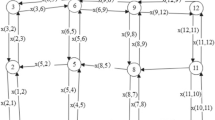Abstract
This paper presents an innovative method to facilitate making such a plan. Using an algorithm to schedule the starting time of each evacuation group, the method guarantees that the time of completing a large-scale evacuation is very close to its theoretically shortest evacuation time. Meanwhile, unlike a simultaneous evacuation, during a staged evacuation planned with the proposed method, all evacuees can take the shortest path to a safe exit. Once evacuees start off, they will not suffer any traffic congestion. The above advantages of this innovative method are achieved by using an algorithm with three nested loops. Experiments have been conducted, and their results have validated the proposed method.
Similar content being viewed by others
References
S. Chien and V. Korikanthimath, Analysis and modeling of simultaneous and staged emergency evacuations, Journal of Transportation Engineering, 2007, 133: 190–197.
X. Chen and B. Zhan, Agent-based modeling and simulation of urban evacuation: Relative effectiveness of simultaneous and staged evacuation strategies, Proceedings of the TRB 83rd Annual Meeting, Washington, DC, 2004.
Z. Sinuany-Stern and E. Stern, Simulating the evacuation of small city: The effects of traffic factors, Socio-Econ. Plan. Sci. 1993, 27: 97–108.
P. Murray-Tuite and H. Mahmassani, Transportation network evacuation planning with household activity interactions, Transportation Research Record, 2004, 1894: 150–159.
L. Han and F. Yuan, Evacuation modeling and operation using dynamic traffic assignment and most desirable destination approaches, Proceedings of the TRB 84th Annual Meeting, Washington, DC, 2005.
T. Cova and J. Johnson, Micro simulation of neighborhood evacuations in the urban-wild land interface, Environ. Plan. B: Plan. Des. 2002, 34: 2211–2229.
Y. Chiu, Traffic scheduling simulation and assignment for area-wide evacuation, Proceedings of the 2004 IEEE Intelligent Transportation Systems Conference, Washington, DC, 2004.
T. Cova and J. Johnson, A network flow model for lane-based evacuation routing, Transportation Research Part A, 2003, 37: 579–604.
T. Yamada, A network flow approach to a city emergency evacuation planning, International Journal of Information Science, 1996, 27: 931–936.
L. Chalmet, R. Francis, and P. Saunders, Network model for building evacuation, Management Science, 1982, 28: 86–105.
R. Francis and L. Chalmet, A negative exponential solution to an evacuation problem, Research Report No. 84-86, National Bureau of Standards, Center for Fire Research, 1983.
H. Hamacher and S. Tjandra, Mathematical modeling of evacuation problems: A state of the art, Pedestrian and Evacuation Dynamics, eds. by M. Schreckenberg and S. Sharma, Springer, New York, 2002.
B. Hoppe and E. Tardos, Polynomial time algorithms for some evacuation problems, Proceedings of the 5th Annual ACM-SIAM Symposium on Discrete Algorithms, Arlington, Virginia, 1994.
T. Kisko and R. Francis, Evacnet+: A computer program to determine optimal building evacuation plans, Fire Safety Journal, 1985, 9: 211–222.
Q. Lu, Capacity constrained routing algorithms for evacuation planning: A summary of results, Proceedings of 9th International Symposium on Spatial and Temporal Databases, Angra dos Reis. Brazil, 2005.
Y. Liu, Cell-based network optimization model for staged evacuation planning under emergencies, Transportation Research Record, 2006, 1964: 127–135.
W. Y. Szeto and H. K. Lo, Dynamic traffic assignment: Properties and extensions, Transportmetrica, 2006, 2: 31–52.
Y. Sheffi, Urban Transportation Networks: Equilibrium Analysis with Mathematical Programming Methods, Prentice Hall, Englewood Cliffs, NJ, 1985.
E. Dijkstra, A note on two problems in connexion with graphs, Numerische Mathematik, 1959, 1: 269–271.
Author information
Authors and Affiliations
Additional information
This research was supported by the National Natural Science Foundation of China under Grant No. 40730526, Scientific Research Starting Foundation for Returned Overseas Chinese Scholars (Ministry of Education, China), the Key Lab of Geographical Information Science under Grant No. KLGIS2011C01, Shanghai Natural Science Foundation under Grant No. 11ZR1410100, and Open Grant from Shanghai Key Lab for Urban Ecology and Sustainability (SHUES).
This paper was recommended for publication by Editor Hanqin ZHANG.
Rights and permissions
About this article
Cite this article
Li, X., Huang, B., Liu, Z. et al. A novel method for planning a staged evacuation. J Syst Sci Complex 25, 1093–1107 (2012). https://doi.org/10.1007/s11424-012-0257-4
Received:
Revised:
Published:
Issue Date:
DOI: https://doi.org/10.1007/s11424-012-0257-4




